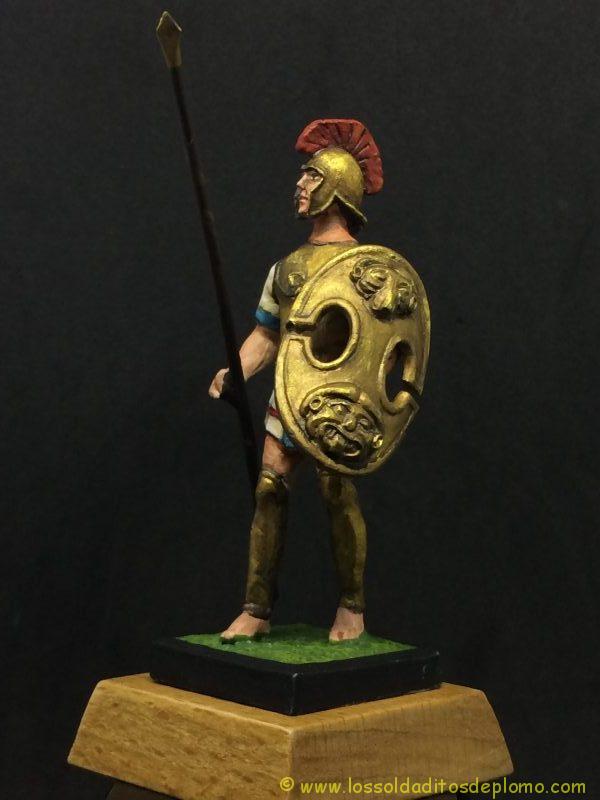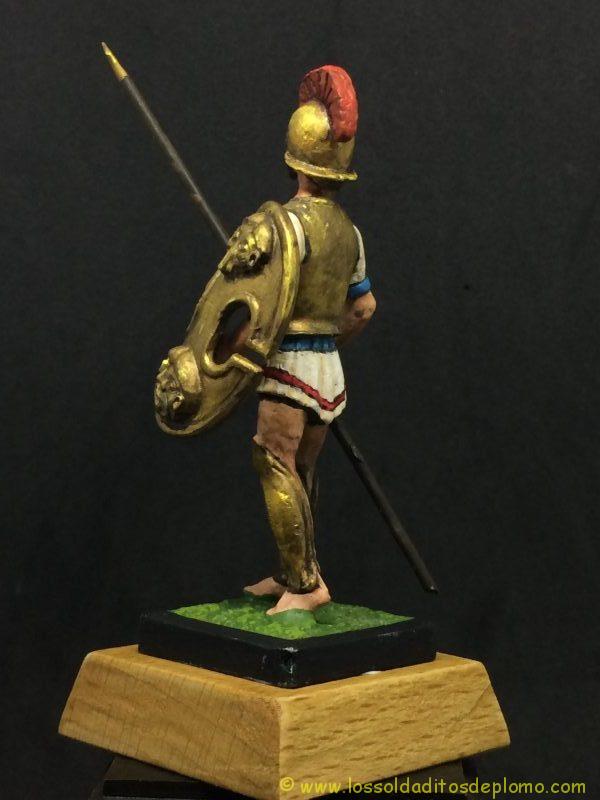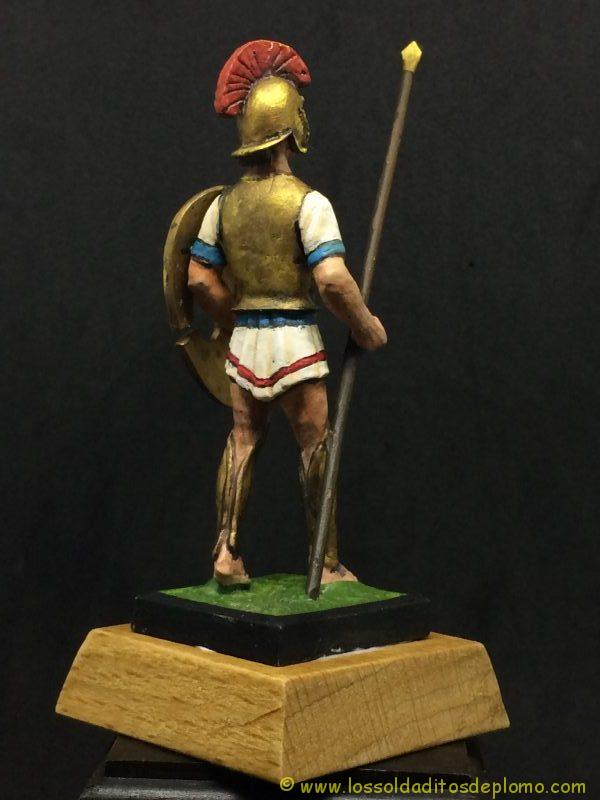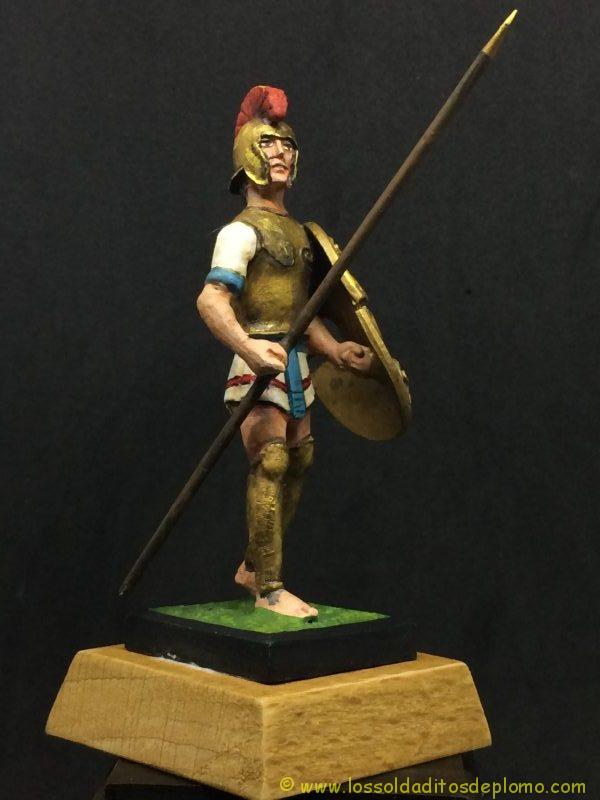EDAD ANTIGUA: Infantería Etrusca 600 A.C.




Los etruscos fueron un pueblo de la Antigüedad cuyo núcleo geográfico fue la Toscana (Italia), a la cual dieron su nombre. Eran llamados Τυρσηνοί, tyrsenoi, o Τυρρηνοί, tyrrhenoi (Tirrenos), por los griegos; y tusci, o luego etrusci, por los romanos; ellos se denominaban a sí mismos rasenna o rašna (Rasenas).
Desde la Toscana se extendieron hacia Umbría y por el sur hacia el Lacio y la parte septentrional de la Campania, donde chocaron con las colonias griegas; hacia el norte de la península itálica ocuparon la zona alrededor del valle del río Po, en las actuales regiones de Emilia-Romaña, Lombardía y la parte sur del Véneto.
Llegaron a ser una gran potencia naval en el Mediterráneo occidental, lo cual les permitió establecer factorías en Cerdeña y Córcega. Sin embargo, hacia el siglo V a. C. comenzó a deteriorarse fuertemente su poderío, en gran medida al tener que afrontar casi al mismo tiempo las invasiones de los celtas y los ataques de griegos y cartagineses. Su derrota definitiva, por los romanos, se vio facilitada por tales enfrentamientos y por el hecho de que los etruscos nunca formaron un estado sólidamente unificado sino una especie de débil confederación de ciudades de mediano tamaño.
En cierto modo predecesora de Roma y heredera del mundo helénico, su cultura (fueron destacadísimos orfebres, así como innovadores constructores navales) y sus técnicas militares superiores hicieron de este pueblo el dueño del norte y centro de la Península Itálica desde el siglo VIII a. C. hasta la llegada de Roma. Hacia el 40 a. C., las diferentes ciudades de Etruria (nombre del país de los etruscos) perdieron su independencia política y se convirtieron en parte del territorio de la Roma republicana (con todo, la presencia etrusca fue siempre destacada, los últimos tres reyes de Roma fueron etruscos).
Los orígenes de los etruscos nunca han estado claros. Se pueden destacar cuatro teorías al respecto:
La teoría orientalista, propuesta por Heródoto, que cree que los etruscos llegaron desde Lidia hacia el siglo XIII a. C. Para demostrarlo se basa en las supuestas características orientales de su religión y costumbres, así como en que se trataba de una civilización muy original y evolucionada, comparada con sus vecinos.
La teoría autóctona, propuesta por Dionisio de Halicarnaso, que consideraba a los etruscos como oriundos de la península itálica. Para argumentarlo, esta teoría explica que no hay indicios de que se haya desarrollado la civilización etrusca en otros lugares y que el estrato lingüístico es mediterráneo y no oriental.
Teoría de un origen «nórdico», defendida por muchos a finales del siglo XIX y primera mitad del XX; se basa sólo en la similitud de su autodenominación (rasena) con la denominación que los romanos dieron a ciertos pueblos celtas que habitaban al norte de los Alpes, en lo que actualmente es el Este de Suiza y Oeste de Austria: los ræthii o réticos, tal origen supuesto sólo en parofonías está ya descartado.
La teoría actualmente más fundamentada viene a ser, en cierto modo, una mezcla de la de Heródoto y la de Dionisio de Halicarnaso: habrían llegado inmigrantes orientales los cuales fueron influidos por los nativos, o, los nativos fueron influidos por los inmigrantes del este. Se considera, por varios rasgos culturales (por ejemplo, el alfabeto), un fuerte influjo cultural derivado de alguna migración procedente desde el suroeste de Anatolia hacia el centro de Italia. Tal influjo cultural se habría extendido sobre pueblos autóctonos ubicados en lo que actualmente es la Toscana.
The Etruscans were a people of antiquity whose geographical core was Tuscany (Italy), to which they gave their name. They were called Τυρσηνοί, tyrsenoi, or Τυρρηνοί, tyrrhenoi (Tyrrhenians), by the Greeks; and tusci, or later etrusci, by the Romans; they called themselves rasenna or rašna (Rasenas).
From Tuscany they extended towards Umbria and by the south towards the Lazio and the northern part of the Campania, where they collided with the Greek colonies; towards the north of the Italian peninsula they occupied the area around the Po river valley, in the present-day regions of Emilia-Romagna, Lombardy and the southern part of the Veneto.
They became a great naval power in the western Mediterranean, which allowed them to establish factories in Sardinia and Corsica. However, towards the fifth century BC. C. began to deteriorate strongly its power, to a large extent to have to face almost at the same time the invasions of the Celts and the attacks of Greeks and Carthaginians. Their final defeat, by the Romans, was facilitated by such clashes and by the fact that the Etruscans never formed a solidly unified state but a kind of weak confederation of medium-sized cities.
In a certain way predecessor of Rome and heiress of the Hellenic world, its culture (they were outstanding goldsmiths, as well as innovative naval builders) and their superior military techniques made of this town the owner of the north and center of the Italian Peninsula from the VIII century BC. C. until the arrival of Rome. Around 40 a. C., the different cities of Etruria (name of the country of the Etruscans) lost their political independence and became part of the territory of the republican Rome (nevertheless, the Etruscan presence was always outstanding, the last three kings of Rome were Etruscans ).
The origins of the Etruscans have never been clear. Four theories can be highlighted in this regard:
The orientalist theory, proposed by Heródoto, that thinks that the Etruscans arrived from Lydia towards Century XIII a. To demonstrate it, it is based on the supposed oriental characteristics of its religion and customs, as well as on the fact that it was a very original and evolved civilization, compared with its neighbors.
The autochthonous theory, proposed by Dionisio de Halicarnaso, that considered to the Etruscans like natives of the italic peninsula. To argue, this theory explains that there is no evidence that the Etruscan civilization has developed elsewhere and that the linguistic stratum is Mediterranean and not Eastern.
Theory of a “Nordic” origin, defended by many at the end of the 19th century and the first half of the 20th; it is based only on the similarity of its self-denomination (rasena) with the name that the Romans gave to certain Celtic peoples who lived north of the Alps, in what is now eastern Switzerland and western Austria: the ræthii or rhetics, such an origin supposedly only in parophonies is already ruled out.
The theory now more grounded becomes, in a way, a mixture of that of Herodotus and that of Dionysius of Halicarnassus: eastern immigrants would have arrived who were influenced by the natives, or, the natives were influenced by immigrants from the east. It is considered, by several cultural features (for example, the alphabet), a strong cultural influence derived from some migration coming from the southwest of Anatolia towards the center of Italy. Such cultural influence would have spread over indigenous peoples located in what is now Tuscany.

